For this station please read this short article on Canadian propaganda posters, you may also want to refer to a dictionary.
Pictures
(From the Canadian War Museum Collection)
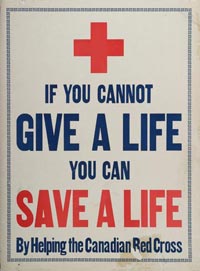
This poster uses words and stark, simple graphics to persuade viewers to give money to the Canadian Red Cross. The phrase “giving a life”, which, in light of the war’s heavy casualties, may have been intended quite literally, establishes an equivalence of sacrifice between those serving overseas, and those who can yet serve by giving at home.
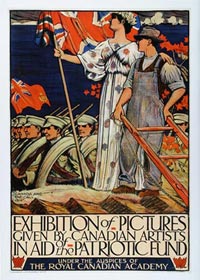
National propaganda plays on a nation’s self-image and historic iconography in order to encourage patriotism and sacrifice. Symbolic figures, including Marianne for France and Uncle Sam for the United States, encapsulate a country’s sense of identity and shared values.
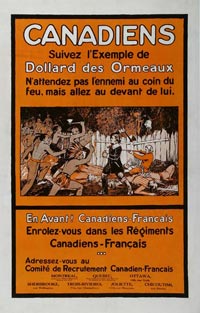
By 1917, the government legislated conscription to force the reluctant to “do their bit.” In Quebec there were few ties to Britain, the war had been a tough sell from the beginning. Because of Quebec’s particular political and social climate, recruitment posters there sometimes used unique forms of appeal not seen in the rest of Canada. Some of French-Canada’s greatest historical heroes and heroines appeared on enlistment posters, for example.
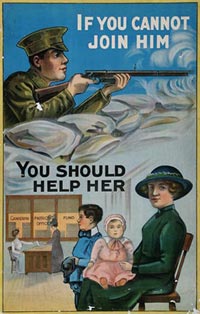
The message here, that the families of those serving overseas were a public obligation, is visually reserved, even Victorian, but also subtly progressive: government’s growing financial obligations to veterans and their families.
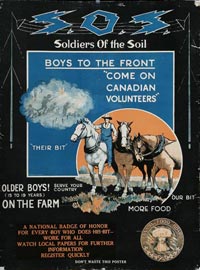
This poster encourages teenaged boys to serve Canada by taking over farm work previously done by men now gone to war. The imagery and language attempts to equate the home front with military service – in effect, militarizing it – to make it appear more attractive to young boys.
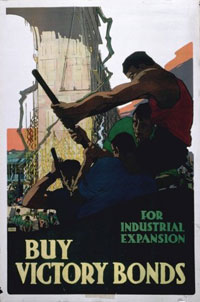
Unlike most posters of the period, which presented themes of patriotism, imperialism, or sacrifice with more or less traditional texts and images, some modern designs derived inspiration from the period’s labour militancy, social – especially urban – reform movements, and various causes of the political left.
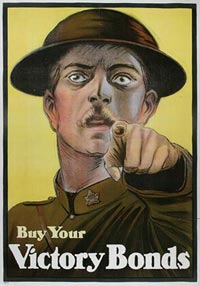
This anonymous First World War Victory Bond poster depicts a Canadian soldier who pointedly asks members of the public to buy war bonds in support of the war effort. The design was loosely based on a First World War United States recruiting poster featuring a pointing “Uncle Sam.” This has proven to be America’s best-known poster ever and has been reproduced in the millions.
Part I
Using the materials provided answer the reflect on the following questions.
Once you have completed the women and the war station you can may wish to add to your answers here.
1- Define propaganda.
2- When (and why) might propaganda be useful (past and present)?
3- What are some of the purposes it was used for during WWI?
4- What were some of the techniques used in the propaganda?
Part II
Using the knowledge you gained in Part I and what you already know about the world today reflect on the following questions.
1- Is propaganda used today? Give some examples. Explain some of the purposes and techniques used in your examples.
2- Has propaganda affected you?
Twitter Question:
Can propaganda be used for good and evil?
#RsideSS11
Please Proceed to Station Three

Leave a Reply